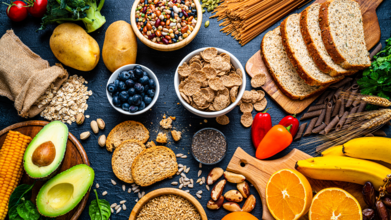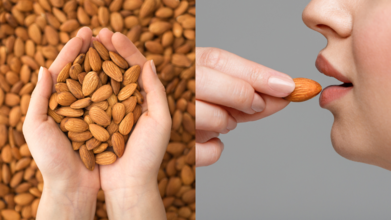- Health Conditions A-Z
- Health & Wellness
- Nutrition
- Fitness
- Health News
- Ayurveda
- Videos
- Medicine A-Z
- Parenting
- Web Stories
Weight Loss: 10 Most Famous Fad Diets Of All Time

Fad Diet (Credit: Canva)
Fad diets are popular eating plans that typically promise quick weight loss or health benefits through unconventional food restrictions or specific food focuses. Often characterized by their extreme nature, such as drastically low-calorie intake or eliminating entire food groups, these diets tend to gain rapid popularity due to celebrity endorsements or viral trends. While they may lead to short-term weight loss, they often lack balanced nutrition and sustainability, making long-term adherence challenging and sometimes unhealthy.
The appeal of fad diets stems from a desire for rapid results in a society that often prioritizes quick fixes. Many individuals seek immediate solutions to weight loss or health improvement, leading them to experiment with these diets. Additionally, the allure of a simplified approach to eating—often framed as an easy path to a desired physique—can be tempting. However, while these diets might offer short-term benefits, it's essential to approach them with caution, as they may not provide the balanced nutrition necessary for overall health and well-being. Sustainable lifestyle changes that incorporate various foods and promote healthy habits are generally more effective for long-term success.
10 Fads Diets For Weight Loss
Atkins Diet
The Atkins Diet emphasizes low carbohydrate intake, allowing daily goals of 20, 40, or 100 grams. Stricter limits often yield quicker weight loss. However, many find it challenging to maintain, as carbs are a primary energy source. Dietitian Leah Reitmayer advises against low-carb diets, emphasizing the need for essential nutrients.
Zone Diet
Popularized by Jennifer Aniston, the Zone Diet focuses on a balance of 40% carbohydrates, 30% protein, and 30% fat. Dietitian Alyssa Smolen notes its merit in promoting whole foods and anti-inflammatory omega-3s. However, certain nutritious foods are restricted, which can make adherence difficult over time.
Keto Diet
Originally developed for epilepsy treatment, the keto diet is high in fat and very low in carbs. It surged in popularity in 2020 but may lead to excessive saturated fat intake and fewer fruits and vegetables. Smolen recommends pursuing keto with professional guidance to ensure a balanced diet.
Grapefruit Diet
This one-food fad diet, like cabbage soup or boiled eggs, restricts calories to under 1,000 per day. While weight loss may occur, dietitians advise against such restrictive eating, stressing the importance of a varied diet for overall health.
Paleo Diet
Inspired by hunter-gatherer eating, the paleo diet includes lean meats, fruits, and veggies while excluding grains. Despite health claims, it lacks whole grains, which are linked to reducing disease risk, and can foster unhealthy dietary obsessions.
Gluten-Free Diet
Essential for those with celiac disease or gluten allergies, the gluten-free diet has gained popularity as a weight-loss solution. However, research shows no evidence supporting weight loss benefits for those without medical needs.
Master Cleanse
This liquid diet consists of a mixture of lemon juice, maple syrup, and cayenne pepper for 10 days. While it may lead to temporary weight loss, it lacks essential nutrients and doesn’t provide lasting results.
Whole30
An elimination diet lasting 30 days, Whole30 has strict rules about food choices. Although popular, it lacks substantial scientific support for its benefits compared to other diets.
Low-Fat Diet
Once popular in the '90s, low-fat diets focused on reducing fat intake to lose weight. Experts now recognize the importance of healthy fats for hormone production and nutrient absorption.
Special K Diet
This low-calorie plan encourages eating Special K cereal for breakfast and lunch, allowing a regular dinner. While easy to follow, it lacks variety and adequate nutrition, making it unsuitable for long-term weight loss.
Another Day, Another Trend: What Is Fibermaxxing and What Are The Experts Saying About It?

TikTok’s health trends never seem to stop, and the latest one is fibermaxxing, a catchy name for something dietitians have already been preaching for years: eat your fibre. While the trend may sound like a clever hashtag, it has got people munching on lentils, oats, berries and veggies like never before. But is this just another health fad? We find out.
What Is Fibermaxxing?
Simply put, fibermaxxing is all about loading up your plate with fibre-rich foods. They include chickpeas, whole grains, flax seeds, fruit skins and all those leafy greens you keep ignoring. The term originated, like every other term, on TikTok, where creators began sharing fibre-loaded meals and showing off their impressive digestive health wins.
The hashtag #fibermaxxing took off in 2023 and has since drawn millions of views. Behind the scenes, the goal of this trend is fairly wholesome: to encourage people to meet their daily recommended fibre intake.
Why Experts Say It is Actually a Good Idea but in Moderation
Fibre has always been a nutritionist's favourite. Health experts have been saying it forever: getting enough fibre every day can seriously boost your overall health. It helps keep your digestion on track, keeps your blood sugar steady, and even brings down cholesterol levels. On top of all that, it has been linked to a lower risk of heart disease, type 2 diabetes, and some cancers.
Plus, fibre keeps you feeling full for longer, which means fewer snack attacks and better weight management without trying too hard.
How Much Fibre is Too Much Fibre?
As with most TikTok trends, the issue is not the idea but the excess. Experts caution that suddenly jumping on the fibermaxxing trend without building up gradually can lead to bloating, gas, constipation, or the dreaded combination of all three.
Fibre draws water into the digestive tract and bulks up stool, which is great, but only if your body is used to it and you are drinking enough fluids. Adding too much too soon can overwhelm your gut and leave you feeling worse, not better.
If your stomach tends to be on the sensitive side or you have something like IBS, suddenly flooding your system with a ton of fibre can actually make things worse. Instead of feeling lighter and healthier, you might end up feeling gassy, bloated or straight-up uncomfortable. So while this trend is all about gut health, jumping in too fast can totally backfire.
How to Fibremaxx Without Wrecking Your Stomach
- Take it slow: Do not shock your system. Add a little more fibre to your meals every few days so your gut has time to catch up.
- Hydrate like a champ: Fibre needs water to do its thing. If you are not drinking enough, you could end up feeling more blocked than balanced.
- Stick to real food: Go for natural, whole sources like fruits with the skin, veggies, lentils, oats, brown rice, nuts, and whole grain everything.
- Mix your fibre types: Soluble fibre like oats, apples and flaxseeds helps with digestion, while insoluble fibre like leafy greens and whole grains keeps things moving.
- Do not go overboard: A giant portion of lentils might look cool in a reel, but your stomach might not agree. Keep it balanced.
Easy Ways to Add More Fibre
- Swap white rice for brown or red rice
- Sprinkle chia or flaxseeds on your yoghurt
- Stir lentils into your soups, dals, or pasta sauces
- Munch on roasted chickpeas or a handful of almonds
- Do not peel your apples or cucumbers
- Start your day with oats or a whole grain cereal
Heart Healthy And Lowers Blood Pressure - This Colorful Vegetable Is Your Answer To A Healthy Future

(Credit-Canva)
Known as a silent killer, high blood pressure is a much more common issue than we believe. It is a condition where the blood pushes against your artery walls, creating pressure. It not only increases the chances of heart disease and strokes but was a contributing cause of 664,470 deaths in the US, according to the Centers of Disease Control and Prevention. So how does one tackle this issue?
New research suggests that drinking a bit of vegetable juice every day might help older folks lower their blood pressure. Beetroot juice is especially good because it has a lot of something called nitrate. Nitrate is important for how our bodies work and has been linked to lower blood pressure and healthier blood vessels.
How Beetroot Juice Might Work: A Mouth-Body Connection
Researchers at the University of Exeter believe that beetroot juice's positive effects on heart health could be due to changes it makes to the bacteria in your mouth.
In their study, participants drank either regular beetroot juice (full of nitrate) or a placebo drink (with nitrate removed). When people drank nitrate-rich beetroot juice, tests showed a decrease in certain mouth bacteria called Prevotella and an increase in beneficial bacteria like Neisseria.
Notably, older participants in the study started with higher blood pressure on average. Their blood pressure went down after drinking the nitrate-rich beetroot juice, but not when they drank the placebo.
Science Behind Why It Helps
One of the researchers explained that this study shows how foods rich in nitrate can change the tiny organisms in our mouths. These changes could then lead to less swelling (inflammation) in the body and help to lower blood pressure in older people. This discovery is exciting because it opens the door for bigger studies to look more closely at how things like what we eat, and even if someone is male or female, affect how their body reacts to getting more nitrate from their diet. It helps us understand the hidden ways food can impact our health.
What the Study Found
The study involved two groups of adults: one group of 39 younger people (under 30 years old) and another group of 36 older people (in their 60s and 70s). Each person in the study tried both the real beetroot juice and the fake juice for two weeks at a time. The researchers observed that the changes in mouth bacteria happened in both the younger and older groups. However, the drop in blood pressure was only seen in the older participants.
Another researcher from the study mentioned that we already know that eating foods rich in nitrate is good for our health. She also pointed out that as people get older, their bodies naturally produce less of something called nitric oxide, which is important for blood vessels. Older adults also tend to have higher blood pressure, and high blood pressure can lead to serious heart problems like heart attacks and strokes. So, encouraging older adults to eat more vegetables with nitrate could offer really significant and lasting health benefits.
Can Almonds Help Reverse Prediabetes Problems? Experts Have An Answer

India is often described as the “world’s diabetes capital”. Cardiometabolic diseases have reached epidemic levels across the globe, with nearly one in three deaths attributed to cardiovascular diseases. It is worth noting that poor dietary choices have fuelled the epidemic of diabetes and heart disease. It is vital to consider how whole foods, like almonds, may play a role in protecting our health.
Dr. Anoop Misra, Chairman of Fortis Centre for Diabetes, Obesity and Cholesterol (C-DOC) and head of the National Diabetes Obesity and Cholesterol Foundation (NDOC), recently teamed up with ten global health and nutrition experts to publish a paper that dives into decades of research on almonds. Together, they reached a unanimous conclusion: eating almonds every day can significantly improve heart health, help manage weight, regulate blood sugar, and boost gut health.
What stood out in their findings was that almonds may be particularly helpful for Indians with prediabetes, who are more vulnerable to progressing to full-blown diabetes compared to other ethnic groups.
Why Almonds Deserve Their Superfood Status
It is true that almonds are one of the most researched foods. They pack a punch with their rich nutrient profile, offering plant protein, healthy fats, fibre, and a host of vitamins and minerals. What makes them even more convenient is their portability and shelf stability, making them easy to include in any kind of diet.
Tackling the Cardiometabolic Crisis
Cardiometabolic diseases account for nearly one in three global deaths, says Dr. Misra, stressing the importance of finding simple dietary solutions. Whole foods like almonds could be the key to preventing and managing these conditions. He and his co-authors outlined four major benefits of almond consumption in their research.
1. Almonds are Good for Your Heart
Dr. Misra says that almonds are particularly good for the heart. They help lower “bad” LDL cholesterol and diastolic blood pressure. There is strong evidence that replacing saturated fats with unsaturated fats like the ones found in almonds can decrease the risk of heart disease. This heart-healthy swap could be a game-changer for people across India and beyond.
2. Almonds Help You Lose Weight
Almonds can also aid in weight management. Dr. Misra says that eating more than 50 grams a day may even result in slight weight loss. Thanks to their protein and fibre content, almonds help control hunger, which might lead people to naturally consume fewer calories throughout the day.
3. Almonds are Great for Your Gut
Your gut loves almonds too. According to Dr. Misra, daily almond intake can positively alter the gut microbiome by encouraging the growth of good bacteria and increasing the production of short-chain fatty acids. These changes can help reduce body fat and promote overall wellbeing.
4. Almonds Help Regulate Blood Sugar
When it comes to managing blood sugar, almonds show powerful effects. “Research shows a significant reduction in fasting blood glucose and HbA1C with daily almond consumption”, especially in Asian Indians with prediabetes, says Dr. Misra. The research spans various populations in India, from adults with type 2 diabetes to adolescents with prediabetes, all showing notable benefits with regular almond intake.
Cracking the Code of Prediabetes Reversal
Calling the reversal of prediabetes to normal blood sugar levels “the holy grail of medicine”, Dr. Misra shares exciting findings from two recent studies by his team at NDOC. Participants ate a small handful of almonds three times daily before meals. Results were promising: short-term gains in just three days and longer-term benefits over three months, where nearly 23.3 per cent of people reversed their prediabetes.
“These findings underscore the potential of almonds as an accessible and nutrient-dense food to combat the growing burden of cardiometabolic diseases,” Dr. Misra concludes.
© 2024 Bennett, Coleman & Company Limited



